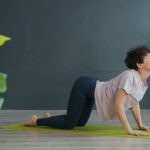What if your daily walk after 70 isn’t keeping you young, but quietly speeding up the aging process? It might sound surprising, but many active seniors find that relying only on walking can lead to weakness, balance issues, and joint pain over time.
Walking is wonderful for heart health and mood, but it’s not enough to keep you strong, steady, and independent as you age. Your body needs a variety of movements to thrive.
In this article, you’ll discover five essential types of exercise that go beyond walking to help you build strength, improve balance, and move with confidence.
Strength Training: Your Body’s Quiet Shield
After age 50, muscle mass naturally declines, a condition called sarcopenia. By 70, this can make everyday tasks like carrying groceries or rising from a chair challenging. Walking doesn’t work key muscles like your glutes, core, or arms effectively.
Strength training builds the invisible armor that keeps you independent. You don’t need a gym or heavy weights. Start with simple exercises:
- Wall push-ups while waiting for water to boil
- Chair squats during TV commercials
- Lifting soup cans or light dumbbells
Just 10–15 minutes, three times a week, can make a dramatic difference. Try standing up from a chair without using your hands. If it’s hard, that’s a sign your muscles need more support.
Balance and Stability: The Forgotten Skill
Balance isn’t a trait you’re born with—it’s a skill that fades without practice. Walking is a repetitive forward motion that doesn’t challenge your body’s internal balance system. This is why falls are a leading cause of injury for seniors.
Improve your balance with easy daily drills:
- Stand on one foot while brushing your teeth
- Walk heel-to-toe in a straight line
- Practice side-stepping with eyes closed for a few seconds
These exercises wake up your ankle stabilizers and improve reaction time. Within weeks, you’ll feel more confident on your feet.
Flexibility and Mobility: Move Freely in All Directions
Walking mostly moves you forward in a straight line. It doesn’t rotate your spine, stretch your hips, or open your chest. Over time, joints can stiffen, making it hard to turn your head, reach overhead, or bend comfortably.
Mobility drills can restore your range of motion. Try these gentle moves:
- Seated spinal twists while watching TV
- Neck rolls each morning
- Arm sweeps and ankle circles before bed
Check your mobility now: sit tall and slowly turn your head left and right. If you feel tight, your body is asking for more variety.
Core and Posture: Your Silent Foundation
Weak core muscles can cause slouching, back pain, and poor balance. Walking doesn’t activate the deep muscles that support your spine and pelvis. This can affect your breathing, digestion, and overall stability.
Rebuild your core with these simple habits:
- Stand against a wall for two minutes daily
- Do seated pelvic tilts during breaks
- Practice core bracing with deep breaths
Test your posture: can your head, shoulders, and tailbone all touch a wall at once? If not, it’s time to focus on your core.
Joint-Friendly Movement: Move Smarter, Not Harder
Repetitive walking on hard surfaces can strain knees, hips, and ankles, especially if supporting muscles are weak. It’s not about doing less—it’s about choosing activities that protect your joints.
Incorporate low-impact options into your routine:
- Water aerobics for buoyancy
- Recumbent biking for cardio
- Chair yoga for stretching and strength
If walking leaves you sore, try sitting in a chair and standing without hands. Discomfort means your joints need more support.
Walking is a great start, but it’s not enough to keep you strong and independent after 70. By adding strength training, balance exercises, flexibility work, core strengthening, and joint-friendly movements, you can age with confidence and vitality.
Start small—just 10–15 minutes a day can transform how you feel. Which area will you focus on first? Share your journey and inspire others to move with purpose.








